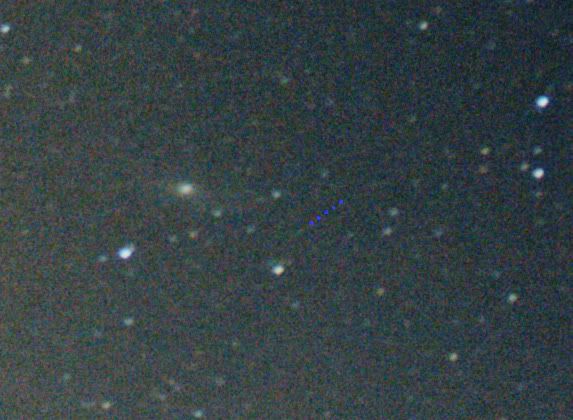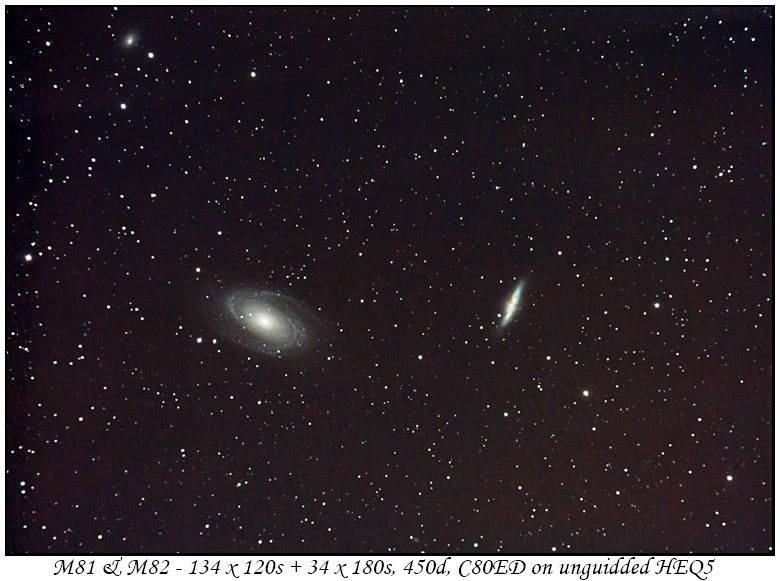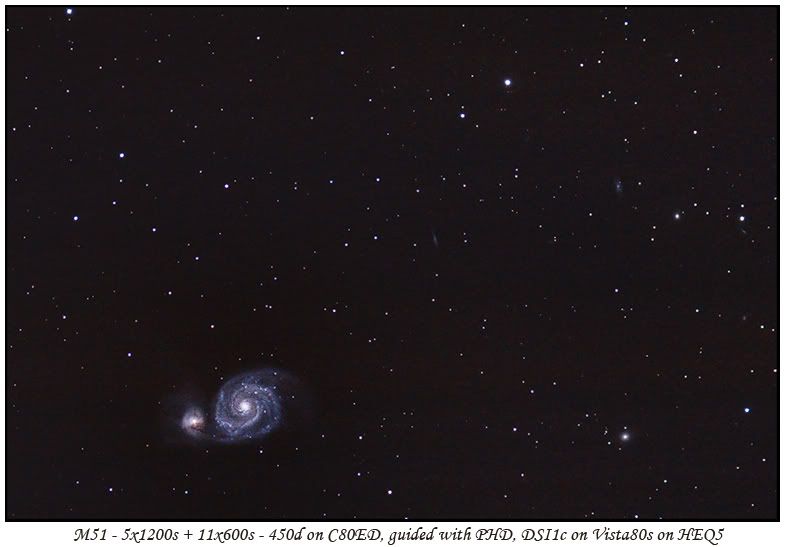After reading a lot of discussion around which ISO is best for Astro imaging, I decided to try an experiment. So, armed with the camera, 18-55 lens, a tripod and timer remote I set out to find out. I took a sequence of 5 shots each at ISO's of 100, 200, 400, 800 and 1600 (the entire range) and combined each set in DSS. The bad news is, the sky conditions were not identical in each image, there was clouds shifting through, a plane joined in the fun. Hopefully though, this won't be a problem.
Each stacked image was stretched and contrast adjusted, using curves only, nothing else has been done. No NR or any other processing. The stretch in each case was stopped when, I could increase the result no further without clipping the white point for the brighter stars.
My intent was to try and get each image looking as close as possible to each other in terms of viewable data.
ISO100
ISO200
ISO400
ISO800
ISO1600
I know I have a gradient and various foreign objects in each image, but I don't think that's an issue for this test. Something that did surprise me, despite the various conversations about when the ISO adjustments are applied is the amount of data that I was able to pull out at ISO100. From these images, my first impressions are that 200 seems to be optimal, both in terms of the amount of content and colours retained.
I then cropped the same (ish, without allowing for field rotation) from each image at about 100% for a peek at the pixels...
ISO100
ISO200
ISO400
ISO800
ISO1600
From these, the additional stretching required on the lower ISO's has introduced more noise in the background, which is kind of what I was expecting, from playing with daytime images and pulling shadow detail out in processing. I think this also shows, I wasn't able to apply the same amount of stretching to the higher ISO images, as I stopped just before clipping the white point. However, all told, I think, for me anyway, that ISO800 is probably easiest to deal with.
I'm sure there are flaws in my testing, the edits were all done at silly o'clock so it may be that more stretching would be possible on the tif's for each ISO. I also can't be certain that each image was fully stretched to it's limit.
Wednesday, 30 September 2009
Testing effectiveness of ISO
Reworking old data
I've been spending some time over the past few days reworking old data. For several reasons, 1) I've got nothing new to work on. 2) To see what I could do with some new tricks I've discovered. 3) To see what effect a couple of changes to the stack made with new information I've read.
Well, first off the stacking. As I've found that darks actually seem to detract from the faint stuff in my images and in fact make noise processing more difficuly, I decided to remove them from the mix. I also read that dSLR's automatically subtract a Bias frame from each image taken. I've only seen it mentioned in one place, but given that when I include bias frames in the mix, I get odd results with horrible green casts (without using a CLS filter) this correlates nicely.
So first off, I went back and redid my M81 M82 data. It took a few goes to get it right, but some tips I found, in the end set me on the right path
Here's the original for reference
The first attempt, where I've overdone the processing...
Then refining a bit more
and finally, about as good as my processing skill can get it at the moment. I'm sure that at some point, I'll be better at this, and will also grab some more data to add, and can therefore improve it further.
I know I've got some oddities in the background on this, that's caused by the odd overlaps between framings over three nights. That's something I do need to work out how to deal with it, but I'll get there in time.
I then moved onto my M51 data. This was originally processed with no darks, but including bias frames, and the green cast is pretty obvious
So, restack, and reprocess, using a similar process overall to the last M81/M82 I ended up with
This time, however, I didn't crop the image, but used the DSS Drizzle feature to enhance the image scale. It's worked, but I'm not sure there's much benefit over cropping to be honest. With cropping the stars in the background remain smaller, but with drizzle they seem to grow a little...
Here's another experiment, but this time with 3x drizzle instead of 2x, this was just to see what the effect would be, and if it was something I could use and get away with in future. 
It's got potential, but I'm not 100% whether it'll be that useful.
Playing with the Jupiter data
I've had a bit of a play with the Jupiter data, aligning the RGB channels amongst other things and it's made quite a difference. I've also managed to get something out of one of the barlowed avi's, it's pretty rubbish really, but it's the first time I've had anything from using the barlow..
and the redited originals
This one being my favourite
Friday, 18 September 2009
First Jupiter
Had a smallish window of opportunity last night, about 30 minutes of outside time. I couldn't be doing with setting everything up, so I popped the Skymax SLT out for a play with Jupiter. I gave it about 40 minutes under a black bin bag (me trust the weather... not likely!!).
I shot 5 AVI's with the SPC900... two are so much mush, the seeing was carp and with the 2x barlow, that was just too much power under the conditions, one was to bring out the moons, but I can't be doing with trying to align everything so didn't bother processing that one. Here's the other two...
1202 of 1202 (I don't now why Regi did that unheard of here)..
579 of 1204 (the moons weren't added.... they were captured in the AVI)
Ah that was fun... I needed that.
Saturday, 12 September 2009
Getting back in the saddle
On the 12th, I had a clear night, and decided to get out the rig and run some tests. First off, getting out the rig was tricky, but with a lot of care (having a bad back really doesn't help), in pieces, I was able to get it all outside and setup. An Obsy really would make this much easier, but I don't have room... never mind.
I checked the level and this was spot on without adjustment, then powered up and polar aligned, amazingly I'd plonked it down so there was only a very minor adjustment on the Azimuth adjusters to get alignment. A check on focus, and a tweak on both the guidescope and imaging scope (although I'd added the TC to the imaging side to get 1200mm and really push the guiding) and good to balance. Started trying to balance the mount, and then my troubles began.. First off trying to get my head around what needed to be moved where with the dual mount bar. Gotta say, balancing with the scopes piggy backed was a lot easier. It did my head in for a while till I discovered that a) I needed to add the second countweight... (not more damn weight)... and I had to re adjust the C80ED tube rings. Being a bright spark, it occurred to me that putting the tube rings as far apart as possible was a really good idea, being more secure etc etc. Until that is, you find that you can't actually shift the OTA and camera far enough forward to get balanced... So in the dark, I dismounted the C80ED with camera and 2x TC still attached (I didn't want to adjust anything around the focus again), grabbed some tools and a camping lantern, and set about moving one of the tube rings along the OTA and dovetail and locking it back in place. I've gotta say this is not the worlds easiest DIY job in the dark (thankfully it wasn't cold to go with it).
Once the rings had been adjusted, allowing more play in the scope position, I was finally able to balance everything out. Phew. So I went for the N star align on EQMOD. Another problem... I couln't get CDC to tell the mount to slew. I tried for about 10 minutes, the mount would move quite happily to my control inputs from both EQMOD and the gamepad, but not from selecting a star in CDC. Till I found I was using the wrong option and instead of telling the mount to goto the star I was telling CDC to centre the star in the view... blast it. Anyway, having finally solved that one, the N Star align was easy. I then slewed around to NGC457 (The Owl Cluster) and set PHD running. After a few minutes, the green box and guiding appeared. I set the camera off on a run of 7.5 minute subs @ ISO800. Then just to finish, as I was testing, set one 20 minute sub running. When that was finished, I grabbed some flats (I forgot about the extent the TC made to the exposure times... ) and cleared up.
Anyway, the guiding worked a treat, even with the TC making 1200mm. Here's the single 20 minute sub. The green tint is from the EOS CLS Clip filter, this really works well on killing the LP around here, much more effective than the Skywatcher LPR filter. This image has had no processing done on it.
And here's the combined results.
I'm happy now that everything is working as it should, and as equally as important, I can also remember how to set it all up and make it work.
Friday, 11 September 2009
In the Telegraph
One of my images from the AstroPhotographer of the year has been used in the publicity release by the Telegraph. It can be seen online Here, it's the Colourful Moon.
Tuesday, 1 September 2009
Astronomy Photographer of the Year
I thought I'd enter some images, all a bit last minute it must be said, and uploaded 5 images to the Flikr group in the final week for submission. Astonishingly 4 of the 5 were short listed. I'm very pleased at this result, as I wasn't expecting to get any. I didn't win, but getting even 1 short listed against the quality of the competition would have been good going. Here's my short listed images...
1) NLC Panorama
2) Misty Iridium Flare
3) Colourful Moon
4) M81 and M82 widefield
Perhaps next year.






